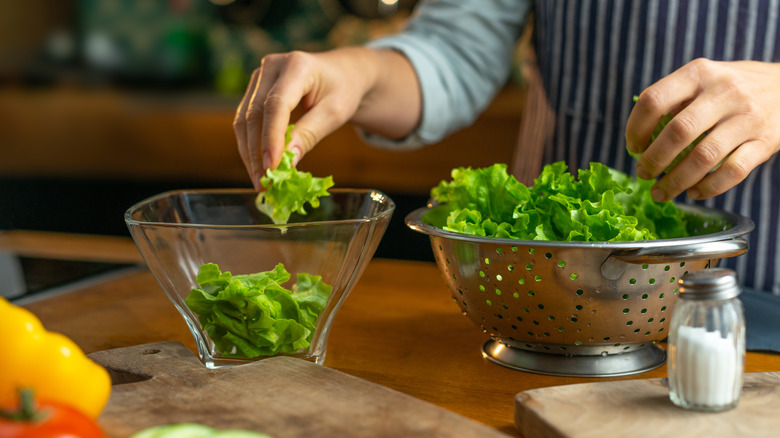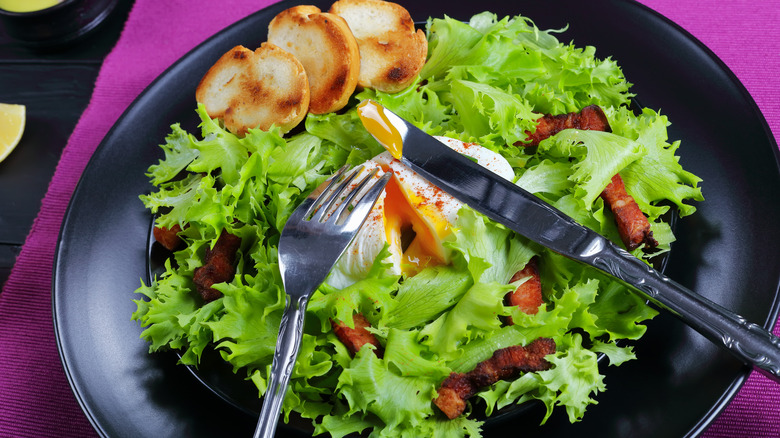French Salad Eating Etiquette Is Unbelievably Strict
In America, people don't really equate ordering and eating a salad with rules. Generally, as long as you chew with your mouth closed, try not to get salad dressing all over your face, and use a fork to eat it, no one would accuse you of having bad table manners or improper dining etiquette. Yet, in France, how you stab your spring mix matters. There, if you order and eat a salad before your main course arrives, don't be surprised if you are greeted by suspicious stares from the next table. And if you dare to use your knife to cut your lettuce into smaller pieces, people may even point at you. What gives?
Both of these deeds are no-nos at the French table, which may come as a surprise because, after all, how are you supposed to eat that huge piece of frisée on your plate? France is renowned for its rich culinary history and many equate the cuisine with a certain degree of class and pedigree. This naturally transitions to the table itself — which could explain the many table etiquette rules the French have that are foreign (pun intended) to Americans. In France, mealtimes are about community and sharing as much as they are about food, so taking your time and appreciating every bite is common practice. Even the salads get respect.
No knives out
French salad leaves never see a knife, neither when they're being prepared for a salad, nor when they are being eaten. Instead of chopping lettuce leaves with a knife, which can cause the tender leaves to brown, they are torn into bite-sized pieces by hand. When it comes to eating the salad, the fork is to do all the work. If you encounter a large piece of lettuce, you are expected to fold it up into a smaller piece (like a little envelope) and place that in your mouth. Some believe it's okay to use your knife to help you fold the lettuce while some won't even give you a knife when the salad course arrives.
The reason you shouldn't cut your salad leaves is that it gives your host or cook the impression that they didn't prepare the salad correctly, and you have to go in and "fix" it. If you find yourself without a knife and a big piece of Bibb on your plate, it's also acceptable to employ a piece of bread to push and fold the leaf onto your fork (bonus: you get a morsel of bread soaked in vinaigrette while you're at it).
This rule may also be a nod to the past when France's aristocracy ate with silverware. When cutting the lettuce, the vinaigrette would tarnish the silver knives. Although most people eat with stainless steel flatware today, the rule has withstood time.
The many salads of France
In France, the salad typically will not arrive until after you've eaten your main course. It's considered a "palate cleanser" to ready your taste buds for the cheese course or dessert, whichever your host determines. In America, salad is often treated as a first course or appetizer. French "salade" can also fall under a number of interpretations. The simplest form of salad is lettuce and a vinaigrette dressing, while composed salads include lettuce topped with other vegetables, meats, cheeses, fruits, and nuts — often named for the region they come from. Some examples include niçoise salad from Nice, which features tuna, anchovies, tomatoes, boiled eggs, and niçoise olives — and salad Périgordine from the Périgord region, made with regional duck or goose foie gras, duck breast, and potatoes.
There are plenty of other rules to abide by while eating a meal in France, from the obvious (elbows off the table, no slurping your food) to the surprising (don't laugh too loud, don't hold your knife or fork in a fist, and don't put your hands under the table). Some of these we, as Americans, adhere to, and others not so much. The rule of thumb is that when in France (and when in doubt), keep a discreet eye on the nearest French person and take note of their superb salad-eating skills.



